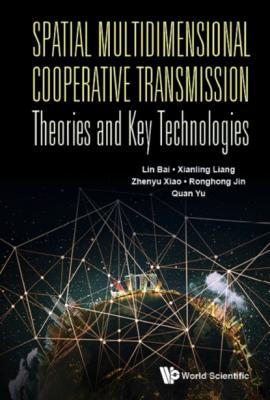Spatial Multidimensional Cooperative Transmission Theories And Key Technologies. Lin Bai
Читать онлайн.| Название | Spatial Multidimensional Cooperative Transmission Theories And Key Technologies |
|---|---|
| Автор произведения | Lin Bai |
| Жанр | Зарубежная компьютерная литература |
| Серия | |
| Издательство | Зарубежная компьютерная литература |
| Год выпуска | 0 |
| isbn | 9789811202476 |
Comparing Eq. (2.14) with Eq. (2.6), we see that the MMSE combination is essentially an MSNR combination.
(3) Maximum likelihood combining
If the transmitted signal s is considered as an estimated parameter, the signal s can be estimated by the maximum likelihood (ML) estimation algorithm. Assuming that vector n in Eq. (2.2) is a zero-mean CSCG random variable, namely
Therefore, the maximum likelihood estimate for signal s is
where the maximum likelihood combining vector is
It is easy to know that the maximum likelihood estimation is actually achieved by adjusting the weight vector wML through a linear combination operation, which we call the maximum likelihood combining.
Comparing Eq. (2.17) with Eq. (2.14), the maximum likelihood combining is essentially an MSNR combination.
(4) Maximum ratio combining
Maximum ratio combining (MRC) is a linear combination technology often used in the fading channel environment, which can effectively improve the system performance of the fading channel. In fact, MRC can be seen as a special case of MSNR combination.
In order to derive the MRC algorithm, we assume that the noise terms in Eq. (2.1) are uncorrelated and their variances are equal, namely E(nnH) = N0I. In this case, the SNR can be obtained according to Eq. (2.12).
According to the Cauchy–Schwartz inequality, it is easy to prove that the combined vector that maximizes SNR is w = αh. This is also a special case of the MSNR combination vector in Eq. (2.14). The linear combination of linear combination vectors w = αh is called MRC.
When the MRC algorithm is applied, the SNR can be obtained.
(5) Generalized selection diversity combining
In wireless communication systems, selection diversity (SD) is also a common spatial diversity technology. Different from the principle that the MRC algorithm combines all the received signals to maximize SNR, the SD algorithm picks out only the strongest signal of the N received signals for processing, which makes it easy to implement.
The SNR of the SD algorithm is
where
In order to improve the performance of SD, a generalized SD combining (GSDC) algorithm is proposed in related literatures. The generalized SD combining selects M signals from the N received signals. When M = N, GSDC is equivalent to the optimal MRC combining. When M = 1, GSDC is a common SD algorithm. It is easy to see that GSDC algorithm has a good balance between performance and computational complexity.
If M signals are obtained under the MSNR standard, the final SNR is
where SNR(k) is the kth maximum SNR of SNRk, k = 1, 2, . . . , N.
2.1.1.2The combining method of unknown channels
The signal combining technologies we discussed above are all based on the assumption that the channel transmission vector h is known. However, in some cases, the channel transmission vector h is difficult to accurately measure, or h is a random variable and there is no accurate value. In this case, when it is necessary to perform a mathematical estimate of the channel transmission vector, the channel transmission vector is regarded as a random variable by considering of the inevitable estimation error.
In the following, the MMSE combining method where the channel transmission vector is a random variable is further analyzed.
Assuming that the expectation and variance of the channel transmission vector h are known, they are given as
When estimating the channel transmission vector h, we can replace its mean vector with the estimated value of h and replace its covariance matrix C with the estimated error covariance of h. In this case, the MMSE combining vector is
If
In the following, we will illustrate the correction of the MMSE combining method.
Assume that the channel transmission vector h = ejϕh0, where ϕ is a random phase vector and h0 is a non-zero constant vector. If ϕ is uniformly distributed,
If the received signal is expressed as
and c = ejϕs is regarded as a new detection signal, then the MMSE combining vector is
However, it should be noted that the MMSE combining vector here is not time-varying. The output of the MMSE combiner is
According to
In general, if the time-varying random channel transmission vector can be decomposed into the known constant and the random variable, then we can realize the application of MMSE in the actual production process by modifying the known signals.
2.1.2Received signal detection
